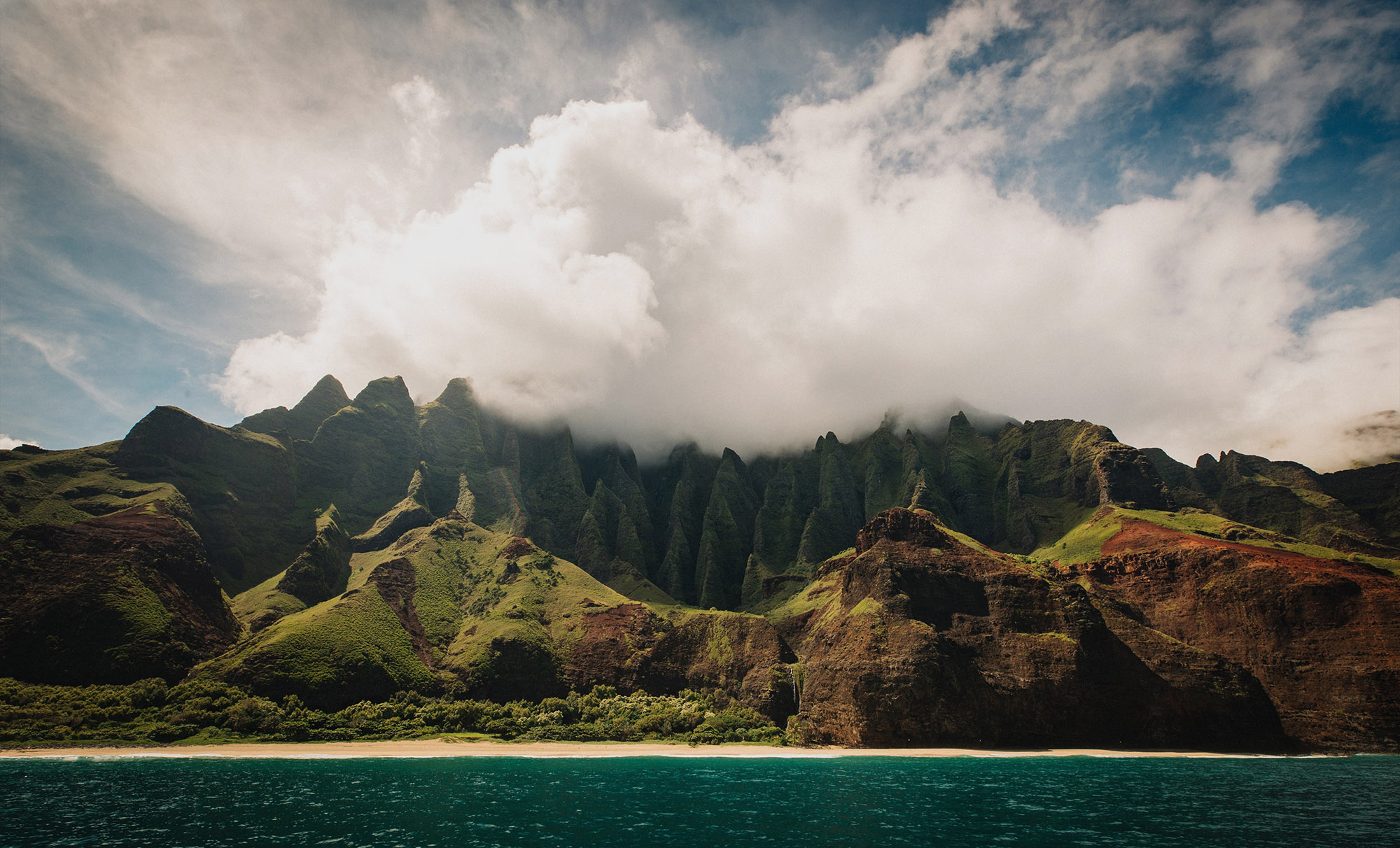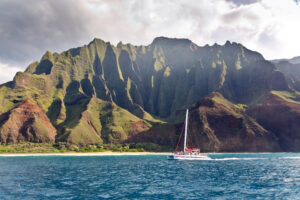
The ruggedly magnificent Nā Pali Coast is a natural wonder, by any measure. With its supernaturally sculpted cliffs and mountains, hidden white-sand beaches, verdant valleys, and cascading waterfalls, Nā Pali is stunningly beautiful—and totally unique as well. No wonder it sits atop the “must-see” list of almost every visitor to Kaua‘i!
Fortunately, there are a number of ways to enjoy this extraordinary destination, and Wailani Kaua‘i’s concierge service knows how to choose the most suitable approach for any schedule, budget, and fitness (or mobility) level. The methods for viewing this spectacular confluence of earth, ocean, and sky can be neatly divided into the parallel categories of land, sea, and air. Each offers a different but equally dazzling perspective on the wondrous coastline, and many visitors include the “Nā Pali trifecta” on the list of things they’d like to experience eventually—or even, if time permits, on a single trip.
In practical terms, we’ll be talking about hiking; a variety of seagoing options; and several types of air tours. Some of these provide an exhilarating physical workout, while others fall into the “Just sit back, and enjoy!” category. Whatever scenario you envision for your own excursion to the amazing Na Pali, you’re bound to find an appealing solution below, and Wailani Kaua‘i’s exceptional concierge team will do everything they can to make your Nā Pali dreams a fantastic reality.
About: The Nā Pali Coast State Wilderness Park, located on the northwestern shore of Kaua‘i, covers 6,175 acres and spans 17 miles, while Haena State Park (which covers 230 acres) includes the trailhead and first stages of the famous Kalalau Trail. The entire area is maintained by the Department of Land and Natural Resources.
Origins: The island of Kaua‘i was formed approximately five million years ago by a massive volcanic event, and the Nā Pali Coast’s majestically sculpturesque topography is the result of several million years of constant erosion by surf, weather, and time.
What’s in a Name?: Nā Pali means “The Cliffs” in Hawaiian (“nā” = “the,” plural).
If You Go: What’s the best way to explore the Nā Pali Coast? Some people swear by the seagoing approach, while others claim that you can’t really get a sense of Nā Pali’s larger-than-life magnificence until you’ve swooped around its otherworldly nooks, crannies, and rock formations in a small, nimble aircraft. Still others are passionate about the earthy immediacy of boots on the ground: hiking, they say, is the most intimate path to immersion in the natural loveliness and epic scale of this extraordinary park. The good news is that everyone is right, because there’s no “wrong” way to experience the Nā Pali Coast. By land, sea, or air, you’re virtually guaranteed an astonishing and unforgettable experience. And if you only have time for, say, a boat tour during your current stay, never fear. This exquisite masterpiece of time, geology, and nature has been in place for untold millennia, and it will still be here, in all its awesomeness, when you return.
 BY LAND
BY LANDThere are several ways to hike Nā Pali, and they all offer sensational views, a challenging trek, and a uniquely memorable experience. The rocky, precipitous Kalalau Trail, in Haena State Park, is the same route used by agricultural traders and by the ancient Hawaiians who made their homes in the magically lush, wild Kalalau Valley. The 11-mile Kalalalu Trail is one of the most difficult hikes on Kaua‘i and, as such, will not be suitable for everyone. If you do attempt this ambitious quest, which is often described as transformational and life-changing, getting there (that is, to the Kalalau Beach terminus) may be at least half the fun. Along the way, you can stop to marvel at jaw-dropping vistas, exquisite beaches, exotic birds, hidden caves, jungly forests, a crystalline river, titanic waterfalls, and an assortment of wildlife.
Completing the entire Kalalau Trail—a rigorous 22-mile round trip—may be the Holy Grail of hiking on Kaua‘i, but there are several other ways to experience this uniquely stunning stretch of coastline on foot. The most popular is to hike from Ke’e Beach to Hanakapiai Beach, then turn around. (This requires a day-pass reservation, but no permit.) The other alternatives, for which you’ll need both reservations and permits, are to hike as far as you like, and then turn back before reaching Kalalau Beach—the end of the trail. More information about our favorite ways to hike the Nā Pali Coast can be found here.
While no aspect of the Kalalau hike could be mistaken for a stroll in the park, either in terms of logistics or degree of difficulty, Wailani’s full-service concierges can help you assess the options and navigate the preparation. And if hiking isn’t your cup of tea, the other approaches to experiencing Nā Pali—by sea, or by air—are guaranteed to yield an unforgettable adventure, as well.

BY SEA
Viewing the precipitous lava-rock cliffs, lushly mantled in deep-green vegetation, from the ocean is always a thrill for the senses: sight, of course, but also hearing (exuberant birdsong, crashing waves); smell (fresh, salty breezes and the rich aroma of ancient earth); touch (the feel of the infinitely lively, profoundly powerful ocean beneath our trailing fingertips); and even taste, when a refreshing splash of salt spray happens to hit us right in the face. There’s an abundance of ways to admire the Nā Pali Coast from the sea—not only via specialized boat tours and expeditions, but if you’re in the mood (and your skills are up to the physical demands), an exciting array of self-guided options, as well.
Boat Tours & Excursions: There are a number of tour companies that offer half and full-day tours down the Nā Pali coastline, with a variety of options to customize your experience that will leave you wanting to come back over and over again until you’ve done them all. From sport-fishing and sunset cruises, to scuba diving, snorkeling, sightseeing, and visiting ancient Hawaiian villages, the options are seemingly endless. For the more adventurous types, the coastline can also be traversed by kayak, paddleboard or, as the Hawaiians did, by canoe.
Seasonal Events:

From a distance, the darting helicopters may look like giant dragonflies, but the views they offer of Nā Pali’s majestic volcanic-rock formations are like those enjoyed by the highest-flying seabirds. Another way to enjoy an aerial perspective is to sign up for one of the frequent tours that utilize small airplanes, biplanes, or ultralights. Whatever the aircraft, some itineraries focus solely on Nā Pali, while others also soar over such thrilling sights as Waimea Canyon, Menehune Fishponds, the Tunnel of Trees, Lumahai Beach, Waita Reservoir, Mount Waialeale (one of the wettest spots on earth), and towering, rain-fed waterfalls.